Cochlear Implants in Singapore: Powerful Tools That Boost Your Hearing
What is a Cochlear Implant?
A cochlear implant is an advanced hearing device that helps deaf or severely hard-of-hearing children and adults. As of December 2019, around 737,000 of these implants are used worldwide, with over 118,000 in adults and 65,000 in children in the United States.
Studies show cochlear implants can significantly improve hearing, especially in noisy environments. They often boost speech understanding by 60-70% compared to hearing aids. These implants are a testament to medical technology, offering a lifeline to those with severe hearing loss, reconnecting them to the world of sound.

How Does a Cochlear Implant Work?
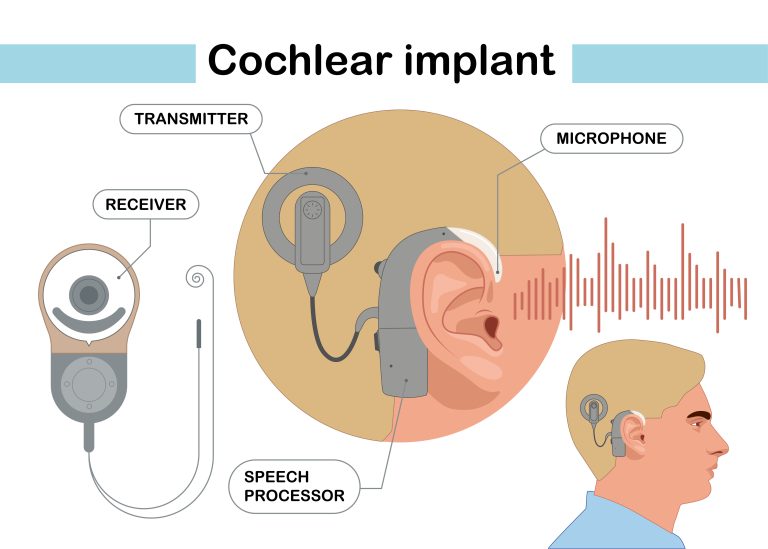
A cochlear implant is a special type of hearing implant. Unlike regular hearing aids, it doesn’t just make sounds louder. Instead, it works differently to help people who have severe hearing loss. A cochlear implant consists of two main parts:
- External Sound Processor: This part, worn behind the ear like a hearing aid, picks up sounds from your surroundings.
- Internal Electronic Device: This tiny device is surgically placed under the skin.
Here’s how it works:
- Capturing Sounds: The external sound processor works like your ears, capturing sounds.
- Converting to Electrical Signals: These captured sounds are converted into special electrical signals. This step is different from normal hearing.
- Bypassing the Damaged Parts: In some people, the inner ear (cochlea) is damaged and can’t convert sounds effectively.
- Direct Stimulation of the Auditory Nerve: Instead of relying on the damaged cochlea, the cochlear implant sends electrical signals directly to the auditory nerve. Think of it as a pathway from the ear to the brain.
- Interpreting Sounds: The auditory nerve carries these signals to the brain, which interprets them as sounds. This allows someone with a damaged inner ear to hear.

Who is the Cochlear Implant For?
Cochlear implants are an effective solution for a diverse group of individuals with conditions related to the ear structure. This includes deaf people who have profound hearing loss and those with less severe forms of hearing impairment. They are particularly beneficial for.
✓ Individuals with Sensorineural Hearing Loss: This type of hearing loss involves damage to the inner ear or the nerve pathways to the brain.
✓ Severe to Profound Hearing Loss: Those who experience significant hearing challenges are prime candidates for cochlear implants.
✓ Limited Benefit from Hearing Aids: Ideal for individuals who have not experienced substantial improvement with traditional hearing aids.
✓ Intact Auditory Nerves: Essential for the implant to effectively stimulate the nerve and produce sound.
✓ Adults and Children Alike: Cochlear implants can be a life-changing solution for people of all ages, helping to improve communication, social interactions, and overall quality of life.
Each candidate’s suitability for an implant is carefully assessed by our team of specialists, ensuring the best possible outcomes.
Schedule online. It’s easy, fast and secure.
Types of Cochlear Implants
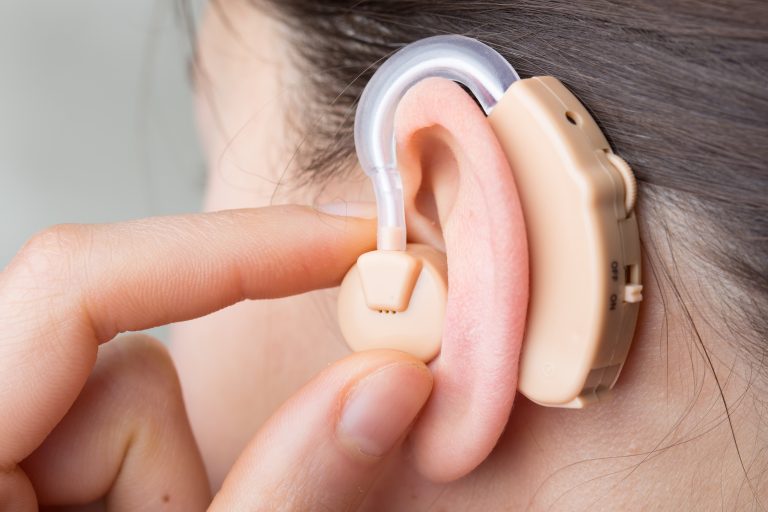
1. Electrode Array Variations
- Single Channel Implant: Offer basic sound perception with a single electrode. Suitable for simple sound awareness.
- Multi-Channel Implants: Provide nuanced sound perception, ideal for complex hearing issues like single-sided deafness.
2. Implant Design Differences
- Behind-The-Ear (BTE) Models: Feature an external processor worn behind the ear, known for ease of handling.
- Body-Worn Processors: Larger, body-worn external processors with more accessible controls.
- On-Scalp Processors: Attach directly to the scalp, offering an alternative wearing method.
3. Sound Processing Strategies
- Analog Processing: Simpler, continuous sound wave replication. Less common in modern implants.
- Digital Processing: Advanced, breaking sound into digital signals for precise hearing experiences.
4. Connectivity and Compatibility
- Wireless Connectivity: Offers features like Bluetooth for direct streaming from various devices.
- Compatibility with Assistive Devices: Works with assistive listening devices, beneficial in noisy environments or for educational purposes.
Choosing the right cochlear implant involves understanding these differences and consulting with a medical professional. At Nuffield Medical, comprehensive guidance is provided to align your choice with your lifestyle and hearing needs.
Cochlear Implant Brands
At Nuffield Medical, we understand the importance of quality hearing solutions, which is why we proudly offer cochlear implants from three of the industry’s top manufacturers: Medel, Cochlear, and Advanced Bionics. Each of these brands brings unique features and strengths to the table, and our goal is to help you find the implant that best suits your individual needs.
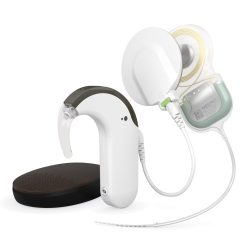
Medel
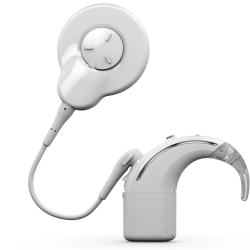
Cochlear
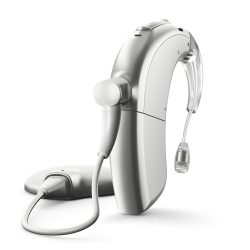
Advanced Bionics
Medel is all about giving you a natural-sounding experience. They design their implants to be comfortable and user-friendly, using the latest technology to help mimic the way we naturally hear sounds. This means their implants are great for a wide range of hearing levels.
Cochlear implants stand out for their ease of use and robust connectivity. These implants are designed to be user-friendly and durable, making them a great option for people of all ages. At Nuffield Medical, we offer Cochlear’s range, emphasising their reliability and advanced technology.
Advanced Bionics offers implants that excel in delivering clear, rich sound in various environments. If you’re often in challenging listening situations, Advanced Bionics’ implants, available at our facility, could provide the clarity you need.
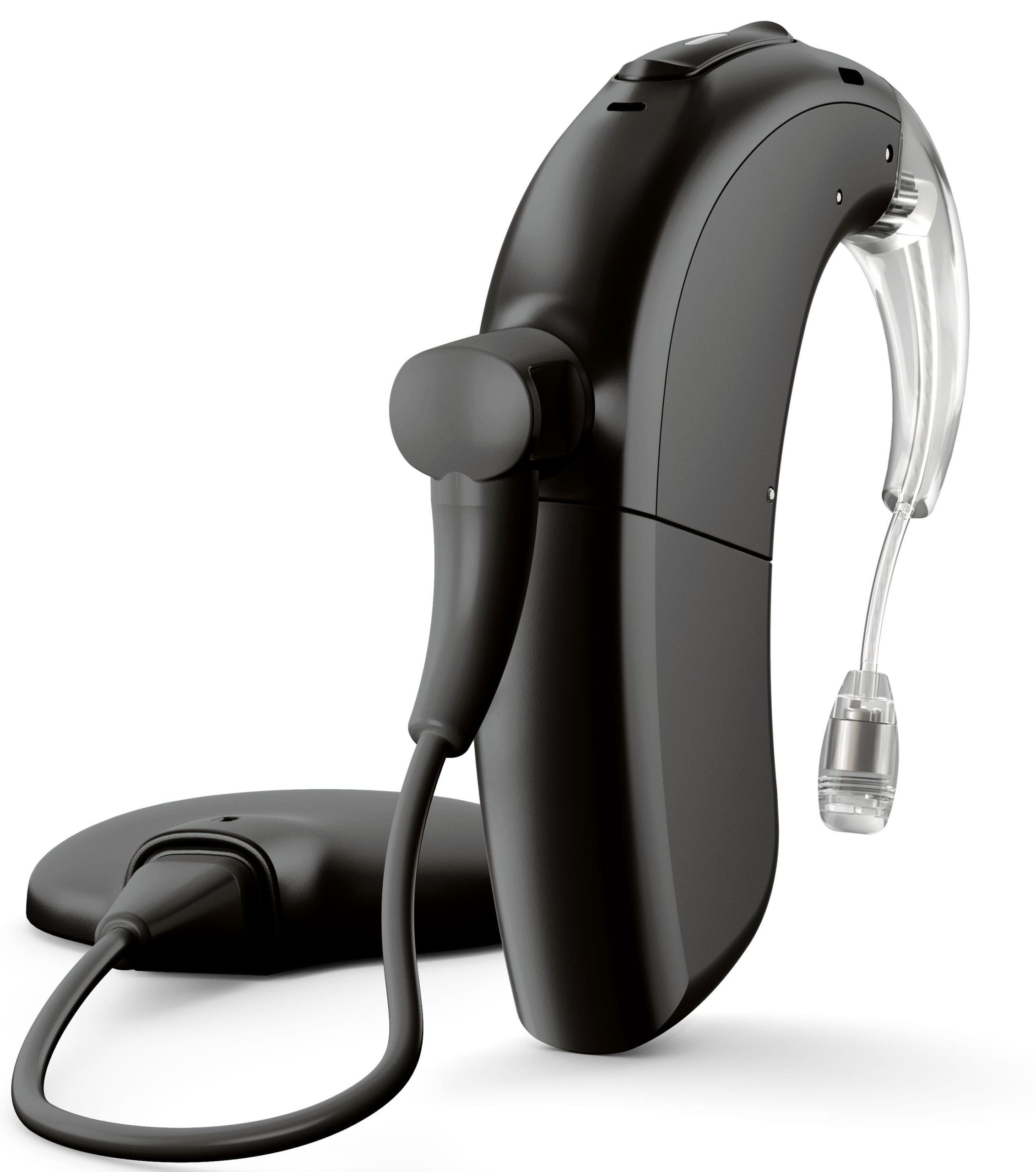
Understanding Your Options in Cochlear Implant Brands
Here in our clinic, we don’t just supply these implants; we also provide comprehensive guidance to help you understand the differences and benefits of each brand. We believe in a personalised approach, where your comfort and satisfaction are our top priorities. Our doctors are more than happy to answer any cochlear implant-related queries you may have.
Schedule online. It’s easy, fast and secure.
Cochlear Implant Procedure
Preparing for Surgery
The process starts with thorough hearing tests, physical exams, and medical history reviews. Once deemed suitable, the patient is scheduled for surgery.
The Surgery Day
Under general anesthesia, the surgery, lasting about 2-3 hours, begins with a small incision behind the ear. A tiny hole is drilled in the skull bone near the mastoid bone to access the cochlea in the inner ear. An electrode array is then inserted into the cochlea to stimulate the auditory nerve.
Post-Surgery Recovery
Recovery involves several weeks of rest and care for the incision site. Follow-up appointments are essential to adjust the implant settings for optimal hearing.
Benefits of Cochlear Implants
Cochlear implants significantly improve hearing, often enabling good hearing in various settings, even with background noise. This is especially beneficial for those who used to depend on lip reading for understanding speech.
Cochlear implants can transform your ability to participate in conversations and enjoy music, making social gatherings more enjoyable. They help bridge gaps in communication, fostering better social connections and overall quality of life.
Cochlear implants offer children the chance to develop language skills more on par with their hearing peers, aiding in crucial speech and cognitive development. This early intervention is key to a child’s academic and social success.
Discussing your medical history is essential for tailoring the cochlear implant process to ensure the best possible safety and results. It helps customise the device settings for optimal performance tailored to your health profile.
Setting realistic goals and having the motivation to engage with your cochlear implant can greatly influence your success. It’s about aligning expectations with what is achievable, ensuring a rewarding journey to better hearing.
Schedule online. It’s easy, fast and secure.
Cochlear Implant Complications
While cochlear implant surgery is generally safe, it’s important to be aware of potential complications, such as bacterial meningitis, loss of residual hearing, dizziness, cerebrospinal fluid leaks, nerve damage and tinnitus. However, these complications are rare, and our team takes every precaution to minimise risks.
Cochlear Implant Risks
Not only are cochlear implants effective, but they are also incredibly safe. Here’s why.
- The FDA has approved the surgical techniques used for cochlear implants.
- With thorough pre-operative check-ups, the chances of encountering problems are very slim.
- Major complications in cochlear implant surgeries are quite rare, occurring in less than 1% of cases.
- This information provides confidence and hope for those considering a cochlear implant for better hearing.

Cochlear Implant Symptoms
Post-surgery, some may experience mild discomfort or tinnitus, but these symptoms typically resolve quickly. It’s crucial to follow post-operative care guidelines for the best recovery and implant performance.
Cochlear Implant vs Hearing Aid
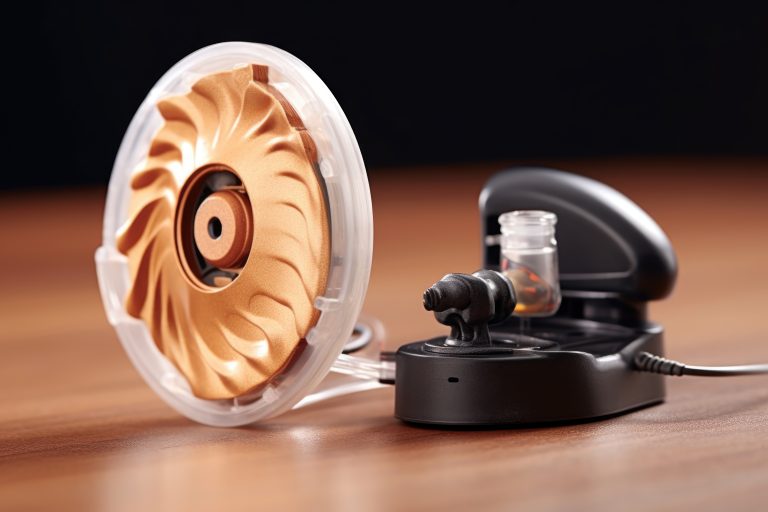
The table below provides a clear comparison between cochlear implants and hearing aids, two prevalent solutions for hearing loss. While both are designed to improve hearing capabilities, they differ significantly in their function, suitability, and benefits. Here’s a concise overview of how cochlear implants and hearing aids compare:
How Long Will It Take Before My Hearing Improves?
Right after getting a cochlear implant, people often hear sounds as artificial or robotic, and voices might sound like they’re speaking through marbles. At first, some might only feel vibrations. The extent of hearing improvement after the surgery differs from person to person.
While you may notice some changes right away, major improvements generally take 6 to 12 months to appear. It can take a year or more to fully recover and get the best hearing possible. This requires regular use of the implant and doing hearing exercises. How much and how fast you improve depends on things like why you lost your hearing, how long you’ve been deaf, and your age when you got the implant.
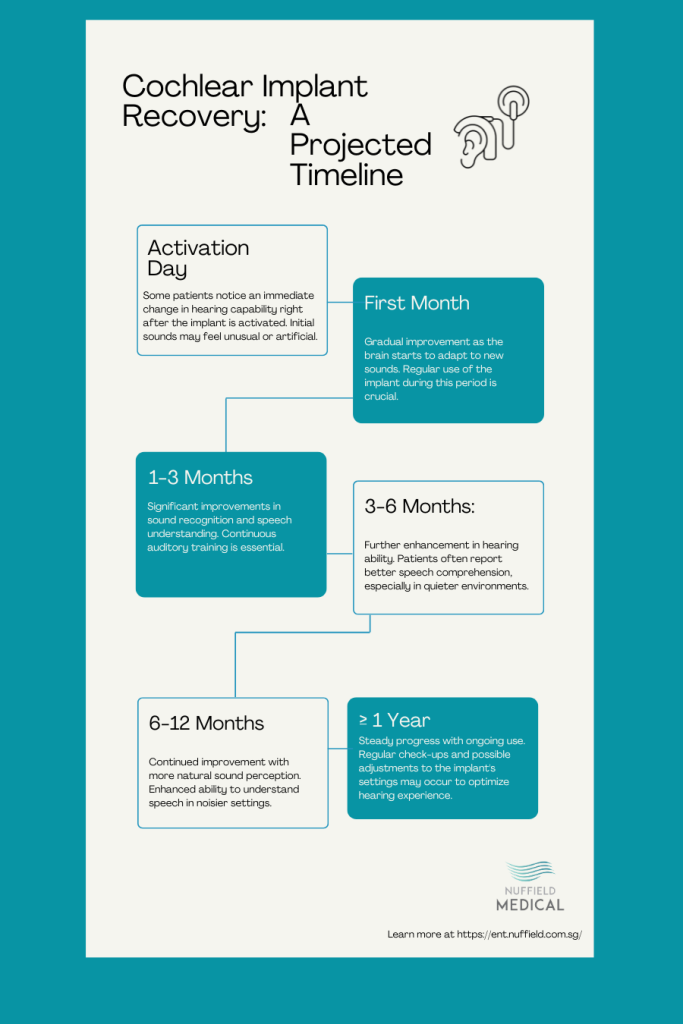
Remember, the graphic above depicts a general timeline and individual experiences may vary. Regular auditory training and consistent use of the implant play a vital role in the improvement of hearing over time.
How Much Does a Cochlear Implant Cost in Singapore?
The cost of a cochlear implant in Singapore can vary significantly based on various factors, including the type of implant, the surgical procedure, and aftercare services. Typically, the price range is as follows:
Basic Cost of the Implant Device: Ranges from SGD 30,000 to SGD 50,000. This includes the internal implant and the external sound processor.
Surgical Procedure Costs: These can range from SGD 10,000 to SGD 20,000, depending on the complexity of the surgery and the medical facility.
Post-Operative Care and Rehabilitation: This essential aspect of the process can vary in cost, typically adding an additional SGD 5,000 to SGD 10,000.
The high upfront cost of a cochlear implant in Singapore, which can range from SGD 45,000 to SGD 80,000 including the device, surgery, and post-operative care, is a significant investment in long-term hearing solutions. However, it’s essential to consider the longevity and life-changing benefits of this technology.
A well-maintained implant can last for over 20 years, offering a sustainable and effective hearing solution. This duration of improved hearing and quality of life often outweighs the initial expense, making it a worthwhile investment for those with severe hearing loss. Additionally, at Nuffield Medical, we support our patients in seeking subsidies and insurance options to ease the financial impact.
Schedule online. It’s easy, fast and secure.

Are There Subsidies for Cochlear Implants?
In Singapore, individuals with severe-to-profound sensorineural hearing loss in both ears can access subsidies for cochlear implants through various programs, including Medisave, Chas, and certain insurance policies.
Additionally, under the Ministry of Health (MOH)’s Implant Subsidy List, it’s possible to receive an implant at a subsidised rate for the first implant in cases of bilateral hearing loss. However, to qualify for this subsidy, applicants must meet specific criteria:
- The management of children (less than 18 years old) and adults with a hearing threshold higher than 70 decibels hearing level (dB HL) without acoustic hearing aids (HA).
- A hearing aid trial of 3 to 6 months is required, unless contraindicated or inappropriate.
- For children, parental support in terms of motivation and commitment to rehabilitation is necessary. Adults must be individually motivated and committed to rehabilitation.
While not every individual may qualify for these subsidies, our team at Nuffield Medical is equipped to guide you through the available financial assistance options, helping you navigate these criteria and find the best financial solutions for your situation.

Case Study: John's Journey to Selecting a Cochlear Implant
Background: John, a 45-year-old graphic designer, experienced a gradual loss of hearing over the past 10 years, leading to a severe-to-profound bilateral sensorineural hearing loss. His hearing loss started affecting both his professional and personal life.
Confirmed severe bilateral sensorineural hearing loss.
Required advanced sound processing for work in video editing.
Chose a water-resistant implant for his active lifestyle, including jogging and swimming.
Audiologist and surgeon recommended models suited to his needs.
Prioritised a discreet design and comfortable fit.
Confirmed severe bilateral sensorineural hearing loss.
Required advanced sound processing for work in video editing.
Chose a water-resistant implant for his active lifestyle, including jogging and swimming.
Audiologist and surgeon recommended models suited to his needs.
Prioritised a discreet design and comfortable fit.
Outcome: John selected an implant that balanced professional requirements, lifestyle compatibility, and personal comfort. Post-surgery, he experienced improved participation in work and social activities.
Conclusion: John’s journey highlights the importance of a personalised approach in choosing a cochlear implant, considering individual needs and professional guidance.
Cochlear Implant Rehabilitation
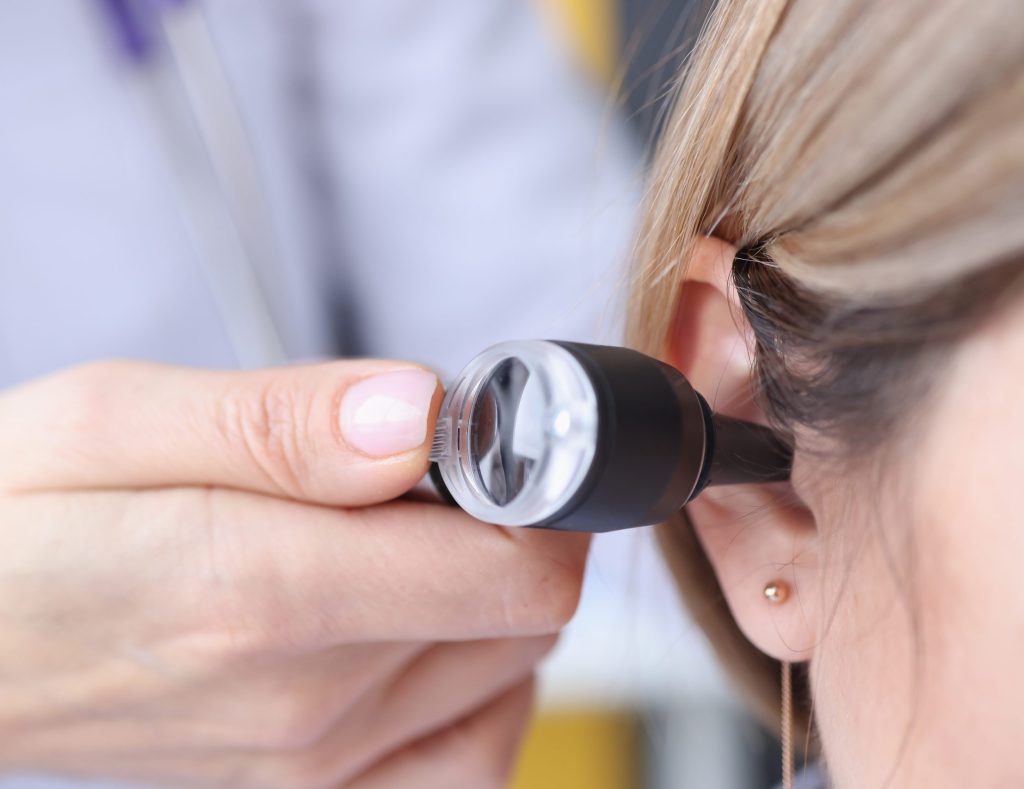
Immediate Post-Operative Care
Immediately following surgery, patients typically experience a brief period of rest and recovery. During this time, it’s crucial to follow the doctor’s instructions closely, which may include:
- Keeping the surgical site clean and dry.
- Avoiding strenuous activities and certain head positions.
- Managing pain and discomfort with prescribed medication.
Long-Term Care and Maintenance
Long-term care for a cochlear implant includes:
- Regular check-ups with your audiologist for device tuning and programming.
- Consistent usage for adaptation and improvement in hearing skills.
- Protecting the external components from damage.
When to Seek Medical Attention
Seek medical attention if you experience:
- Signs of infection at the surgical site.
- Unusual pain or discomfort.
- Sudden changes in hearing or device function.
Cochlear Implants for Children
For children, cochlear implants can be a transformative step, providing:
- A significant boost in developing speech and language skills.
- Better social interaction and academic performance.
- Continuous support and therapy for ideal development.
As a parent, it’s natural to feel anxious about this journey. Rest assured, these implants often open new doors for your child’s growth and learning, offering them a fuller, more engaging experience in their world.

Why Nuffield Medical for Cochlear Implant?
At Nuffield ENT, our team’s expertise is a cornerstone of the exceptional care we provide. Leading the team are Dr. Vyas Prasad and Dr. Rebecca Heywood, each bringing a wealth of experience and specialised skills to our clinic.


Dr. Vyas Prasad: An accomplished ENT specialist, Dr. Prasad’s notable credentials include a Masters in Surgical Sciences from Imperial College, University of London, and extensive training in both adult and pediatric ENT at prestigious hospitals in the UK. His expertise is further enhanced by his advanced training in head and neck surgery at Barts and the Royal London Hospital.
Dr. Rebecca Heywood: With over 25 years of medical experience, Dr. Heywood is a British ENT surgeon specialising in otology and hearing implants. She was awarded a Gold Singapore Health Quality Service Award in 2022. Dr. Heywood completed her postgraduate surgical training in London, with additional experience at the House Ear Institute in Los Angeles and the Ear Science Institute Australia, where she refined her skills under the mentorship of Professor Marcus Atlas.
These two specialists anchor our team at Nuffield ENT, providing patients with unparalleled expertise in the field of ear, nose, and throat care. Our physical clinic is located at Wheelock Place at Orchard, and we are open Monday through Saturday. Feel free to drop by if you’re in the area!
Nuffield Medical Patients Wearing Cochlear Implants






FAQ Section
Cochlear implants boast a high success rate, with most users experiencing significant improvements in hearing and speech comprehension. Studies indicate that over 90% of recipients with profound hearing loss show enhanced ability to understand speech. Success rates vary based on individual factors like age at implantation, the extent of hearing loss, and adherence to rehabilitation. These implants have transformed the lives of many, enabling clearer communication and better quality of life.
There are no absolute age restrictions for receiving a cochlear implant. Infants as young as 12 months can receive them, and there’s no upper age limit. A congenitally deaf child should have cochlear implant surgery before 3 years old, earlier if possible. Candidacy depends more on hearing loss severity and the potential for benefit rather than age alone.
Choosing the right cochlear implant requires evaluating your hearing loss, lifestyle, and preferences. Consider technical aspects like electrode count and sound processing, along with device compatibility and lifestyle fit. Consulting with an audiologist and surgeon is essential; they’ll assess your hearing and recommend an implant tailored to your needs for optimal hearing results.
Cochlear implants are designed as a long-term hearing solution. The surgically implanted component typically remains functional for many years, often exceeding a decade. However, the external processor and other accessories may require upgrades or replacements over time to incorporate
The internal component of a cochlear implant can last for many years, with some lasting over 20 years. Longevity depends on factors like usage, care, and advancements in technology. The external components, like the processor and batteries, have a shorter lifespan and may need replacement every few years. Regular follow-up appointments are vital to monitor the implant’s condition and functionality, ensuring its long-term effectiveness.
Yes, cochlear implants can be upgraded, particularly the external sound processor. As technology advances, newer processors often offer improved features, such as better sound quality, enhanced connectivity, and more user-friendly interfaces. These upgrades can enhance the overall hearing experience without the need for additional surgery. It’s important to consult with your audiologist to understand when upgrades are available and suitable for your specific needs.
Hearing noise in your head after a cochlear implant is common, especially early on. It’s typically your brain getting used to processing sounds in a new way. The implant turns sounds into electrical signals for the auditory nerve, and as your brain adjusts, you might hear odd noises or static. If this noise continues or bothers you, it’s important to check with your healthcare provider or audiologist for advice and possible adjustments.
Caring for the external components of a cochlear implant is essential for optimal performance and longevity.
✓ Keep the processor and microphone clean
✓ Dry, using a soft, dry cloth for cleaning
✓ Avoid exposing them to water, extreme temperatures, or rough handling
✓ Store them in a safe, dry place when not in use
✓ Regularly check for any signs of wear or damage
✓ Replace batteries or damaged parts as needed.
Your audiologist can provide specific maintenance guidelines tailored to your device.
Most patients report minimal pain during and after cochlear implant surgery. The procedure is performed under general anesthesia, so you won’t feel pain during the surgery. Post-surgery, some discomfort, swelling, or numbness around the implant site is common but usually manageable with prescribed pain medication. The discomfort typically subsides within a few days. Your doctor will provide detailed post-operative care instructions to ensure a comfortable recovery.
Regular follow-up visits are crucial after getting a cochlear implant. These appointments allow your doctor or audiologist to check the implant’s functionality, adjust settings, and address any issues. Initial frequent visits are necessary to fine-tune the device for optimal hearing. Long-term, routine check-ups help ensure the implant continues to work correctly and allows for any necessary adjustments or upgrades. Consistent aftercare is key to maximizing the benefits of your cochlear implant.
The internal component of a cochlear implant is waterproof, but the external processor is typically not. Some processors have water-resistant covers or special cases for use during activities involving water, like swimming or bathing. It’s essential to follow the manufacturer’s guidelines regarding water exposure. If your processor is not water-resistant, it should be removed to avoid damage. Consult with your audiologist for specific advice on handling your implant around water.
Yes, you can use a telephone and listen to music with a cochlear implant. Many modern implants have features that facilitate phone usage, like direct audio input or Bluetooth connectivity. Listening to music is also possible, and many users find their appreciation of music improves over time as they adjust to the implant. Some may need practice and rehabilitation to enhance their music listening experience, but overall, cochlear implants significantly improve access to these everyday sounds.
Cochlear implants don’t harm the brain; they actually help it process sounds better. They work by stimulating the auditory nerve directly, skipping the damaged parts of the ear, and sending sound signals to the brain. This can enhance brain functions linked to hearing, especially in those who have had hearing loss for a long time. It’s an example of neuroplasticity, where the brain learns new ways to receive sound, potentially improving skills like listening, understanding speech, and other cognitive abilities related to hearing.
Cochlear implants are designed to be safe and compatible with most other medical devices. However, they can sometimes be affected by or affect other devices that emit strong electromagnetic fields.
- For example, MRI scans require specific protocols when a patient has a cochlear implant.
- Similarly, in rare instances, devices like metal detectors or anti-theft systems might interact with the implant’s external components.
It’s always advisable to inform healthcare providers and security personnel about the implant, and consult with your doctor about any potential interactions with new medical treatments or diagnostic procedures.
Function: They do not restore normal hearing. Instead, they provide a representation of sounds which helps users to recognise speech and environmental noises.
Sound Quality: The quality of sound perceived through an implant can be significantly different from natural hearing. This experience varies from person to person.
Adjustment Period: Users typically undergo a period of adjustment and auditory training to become accustomed to this new way of hearing.
Hearing Enhancement: While cochlear implants can greatly enhance hearing, they might not replicate the full range of sound frequencies that a normal ear can detect.
The future of cochlear implants looks bright, with innovations aimed at helping those with partial hearing loss and combining implants with hearing aids for better sound quality. While the technology is advancing, efforts continue to enhance music enjoyment and speech clarity in noisy environments.
In China, cochlear implants are more common in children, with around 70,000 recipients as of 2022. Thanks to increased funding and support, more children are gaining access to these devices. As the technology evolves and becomes more affordable, it’s expected to benefit a broader range of people, including adults and the elderly.
|
|
|
|
|
|
*Please note that the costs are approximate and specific to the context of Singapore as provided in the content. The benefits and recovery time may vary based on individual circumstances and the specific details of the procedure performed.
Medical References
Boisvert, I., Reis, M., Au, A., Cowan, R., & Dowell, R. C. (2020). Cochlear implantation outcomes in adults: A scoping review. PLOS ONE, 15(5), e0232421. https://doi.org/10.1371/journal.pone.0232421
Lee, S. W., Yuen, H., Low, D. A., Kamath, S., & De Chua, K. W. (2023). The functional impact of implantable hearing devices in patients with single-sided deafness. Proceedings of Singapore Healthcare, 32, 201010582311606. https://doi.org/10.1177/20101058231160604
Völter, C., Götze, L., Dazert, S., Falkenstein, M., & Thomas, J. P. (2018). Can cochlear implantation improve neurocognition in the aging population? Clinical Interventions in Aging, Volume 13, 701–712. https://doi.org/10.2147/cia.s160517
Zeng, F. (2022). Celebrating the one millionth cochlear implant. JASA Express Letters, 2(7). https://doi.org/10.1121/10.0012825
As an ENT surgeon specialized in cochlear implants, I believe it is essential to provide my patients with comprehensive educational resources on hearing loss and cochlear implants. Here are some reputable websites and links that I recommend for anyone seeking more information on this topic:
1.American Speech-Language-Hearing Association (ASHA) – https://www.asha.org/public/hearing/
Cochlear-Implant/
2.The ASHA website provides detailed information on what cochlear implants are, who might benefit from them, the surgery process, and post-implantation rehabilitation. They also have resources for families of children with hearing loss and information on financial support options.
3.Hearing Loss Association of America (HLAA) – https://www.hearingloss.org/hearing-help/technology/cochlear-implants/
4.HLAA offers an overview of cochlear implants and their benefits, including testimonials from people who have received them. They also have a list of frequently asked questions, resources for insurance coverage, and tips for communicating with people who have hearing loss.
5.Centers for Disease Control and Prevention (CDC) – https://www.cdc.gov/ncbddd/hearingloss/
treatment/cochlear-implants.html
6.The CDC website provides a comprehensive overview of cochlear implants, including information on candidacy, the surgical process, and recovery. They also have a list of resources for families, including support groups and financial assistance programs.
7.National Institute on Deafness and Other Communication Disorders (NIDCD).
8.Cochlear Singapore is an example of one of the cochlear implants that I work with: www.cochlear.com/sg
Schedule online. It’s easy, fast and secure.
